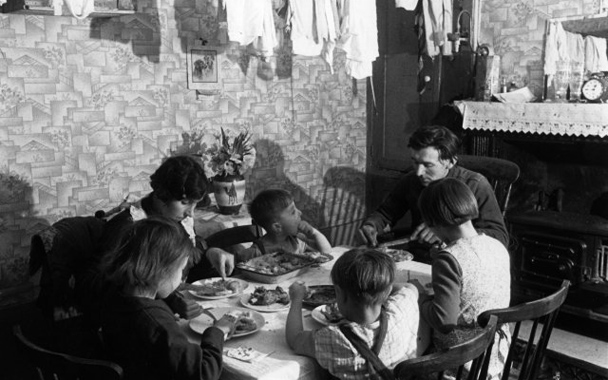It’s fear season, and I’m not talking about the Halloween decorations piled up at the drugstore. Everybody’s on edge these days, everybody’s distracted. And why not? An election far more momentous than any political event should ever be, a war far more pointless than any war should ever be, a financial breakdown so vast and chaotic nobody seems to know how to fix it—small wonder even the nation that invented the happy-face can’t muster a whole lot of optimism right now. On the afternoon before the vice-presidential debate I was so jumpy I closed the computer, went into the kitchen, and made gingerbread. It actually helped. Somehow the sight of that humble brown batter whirling obediently in the mixer calmed me down, and Japanese takeout with friends got me through the debate itself.
Food works, it really does. It delivers generous quantities of support to the human psyche in times of trouble, and the effect is immediate. Eating for comfort works so well, in fact, that it’s easy to overdose; hence the bad reputation that has grown up around this ancient and excellent cure-all. But cooking for comfort—there’s a prescription nobody has ever abused. So with the economy in a shambles, and the future unknown but promising to be unpleasant, I started wondering what it must have been like to cook during the Great Depression. Not that we’re reliving the 1930s yet, but we’re certainly experiencing the same weather: massed clouds of uncertainty, and a daily rain of bad news. No matter what homemakers were putting on the table 70 years ago, it was fear cuisine—and everyone was an expert.
Which may explain the marshmallows that parade through Depression-era salads. And the fresh raspberry glacé to be spread over the fresh raspberry frosting on a three-layer cake. And the icebox cakes, the ginger-ale pie, the layered cream-cheese-and-jelly sandwich loaf garnished with maraschino cherries, and the invention of the chocolate chip cookie. Sugar was cheap in the 1930s, and the economic crisis seems only to have deepened the nation’s longstanding allegiance to dessert. Sweetness became a staple ingredient in fear cuisine, the number-one source of comfort for comfort-food cooks. Thousands of homemakers were grateful for Betty Crocker’s free brochure, “Meal-Planning on Minimum and Low-Cost Budgets,” but the decade’s must-have was “Betty Crocker’s 101 Delicious Bisquick Creations,” which sold nearly three quarters of a million copies at 25 cents each.
The reassuring aura of thrift that emanated from low-cost recipes was definitely the second most important source of comfort in the kitchen. As several historians have noted, most cookbooks published during the ’30s made little mention of hard times and tight budgets. Economical recipes were part of the mix, just as they always had been; but turning the pages of the new kitchen bibles, you’d never have guessed that unemployment was reaching 25 percent. Publishers clearly wanted nothing to do with gloom and lima beans. All the same, plenty of money-saving recipes were in circulation thanks to newspapers, radio programs, and numerous booklets issued by the government and the food industry. Home cooks who were trying to stretch their food dollars with their families’ tastes in mind welcomed any help they could get.
Even so, it’s hard to imagine any homemaker deciding she couldn’t wait to try scalloped onions and peanuts—featured on a low-cost October menu devised by the U.S. Home Economics Bureau—though she might have found the notion of serving hot biscuits with ketchup an arresting one. What we do know is that Winnie G. Ruyle of Skiatook, Oklahoma made such appealing yeast rolls with cornmeal, shortening and sugar that her recipe, “You’ll Like ’Em Mush Rolls,” was published in The Kansas City Journal-Post and won Honorable Mention in the paper’s 1933 recipe contest. Rita Jacob of Kansas City won a dollar for her “Stuffed Shredded Wheat” (each biscuit was stuffed with ground walnuts, topped with butter, and doused in sugar syrup) and Mrs. Joe Ross was awarded a five-dollar first prize for “Polish Meat Dish” (cabbage rolls made of ground beef and rice with garlic and cinnamon). Cost-cutting undoubtedly helped to inspire these recipes, but it’s also true that fear cuisine perked up quite a bit whenever a cash prize was on the horizon.
The third most important source of comfort in this era’s cookery was the taste of America, a proud—or maybe just stubborn—feature of the numerous ethnic recipes that blossomed throughout the Depression. These were recipes that managed to evoke distant lands while remaining firmly on native ground. “Hungarian Meat Loaf with Mexican Sauce and Noodles,” devised for The Kansas City Journal-Post by Mrs. Clair A. Beech, was a standard meatloaf served with a sauce made from carrots, onion, garlic, celery, bouillon-cube broth, cloves, and mace. She may never have left home, but she won a dollar. Aunt Sammy, wife of Uncle Sam and the government’s leading culinary authority, created a “Chinese dressing for salads” (cream cheese, salad oil, lemon juice, and a little Tabasco); and even Irma Rombauer, who normally avoided faux-foreign dishes, came up with “Mexican Veal Steak”—veal slices slathered with canned chili sauce—for her 1939 collection of shortcut recipes, Streamlined Cooking.
It’s not hard to understand the appeal of such dishes, symbols of a sturdy national identity at a time when the most important function of home cooking was to dispel the foreboding in the air. If the dark days get much darker, perhaps we should anticipate a 21st century revival of such desperate emblems of fear cuisine as “Never-Fail Salad” (canned grapefruit, two flavors of Jell-O, cottage cheese, and pickles) and “Success Cake” (all white, with an unspecified “flavoring extract”). And don’t rule out the possibility of seeing Herbert Hoover’s favorite dish—deep-fried venison cutlets—on the menu for White House state dinners. His wife contributed the recipe to The Congressional Cookbook (1933) in honor of the president who hoped positive thinking would end the Depression. She called the recipe simply “Venison” but noted that moose made a fine substitute.




 Pinterest
Pinterest


